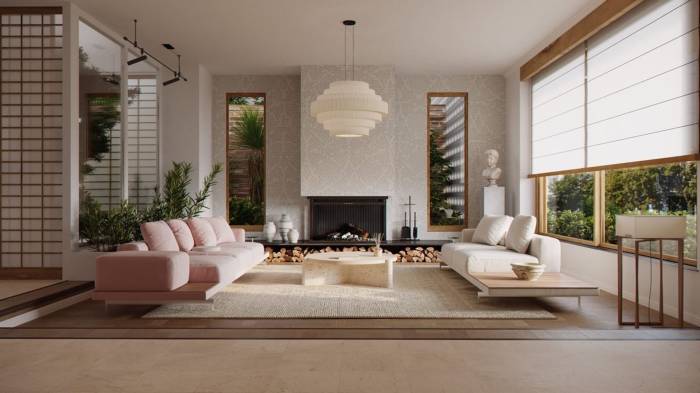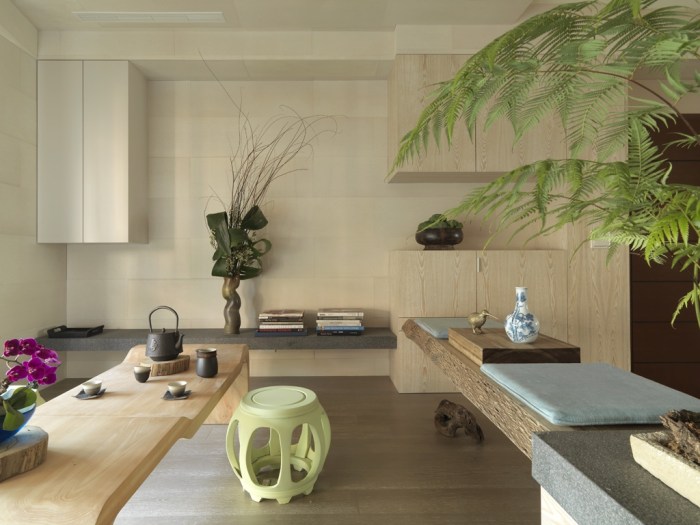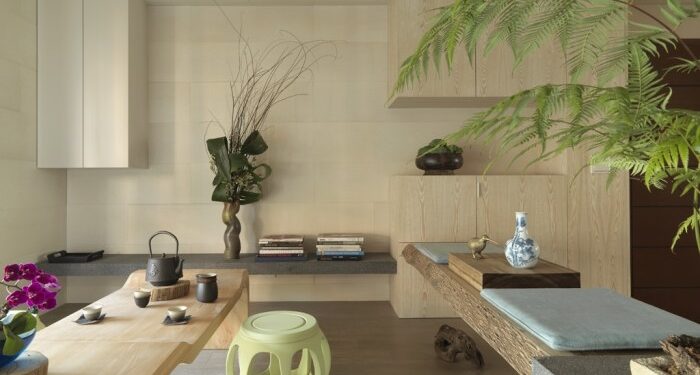Exploring the world of Asian-inspired interior design for modern homes unveils a blend of elegance and tradition that captivates the senses. From the use of natural materials to the incorporation of traditional art, this style offers a unique perspective on creating harmonious living spaces.
Introduction to Asian-Inspired Interior Design

Asian-inspired interior design encompasses the various design elements and aesthetics derived from the diverse cultures and traditions of Asian countries. Key characteristics that define Asian-inspired interior design include minimalism, natural elements, harmonious balance, and cultural symbolism. These elements are combined to create serene and tranquil spaces that promote a sense of mindfulness and relaxation.
Cultural Influences on Asian-Inspired Interior Design
Asian-inspired interior design is heavily influenced by the rich cultural heritage of countries such as Japan, China, Thailand, and India. Each country brings its unique design elements and traditions to the table, shaping the overall aesthetic of Asian-inspired interiors. For example, Japanese interior design emphasizes simplicity, natural light, and the use of natural materials like wood and bamboo.
Chinese design often features bold colors, intricate patterns, and symbolic motifs like dragons and lotus flowers. Thai design incorporates vibrant colors, intricate carvings, and traditional silk fabrics. Indian design showcases rich textures, intricate patterns, and a mix of bright colors.
Popular Asian Countries Influencing Interior Design Trends
1. Japan
Known for its minimalist and Zen approach to design, Japanese interior design focuses on simplicity, natural elements, and creating a sense of tranquility.
2. China
Chinese interior design features bold colors, intricate patterns, and decorative elements inspired by Chinese culture and traditions.
3. Thailand
Thai interior design incorporates vibrant colors, intricate carvings, and traditional silk fabrics, creating a warm and inviting atmosphere.
4. India
Indian interior design showcases rich textures, intricate patterns, and a mix of vibrant colors, reflecting the country's diverse culture and heritage.
Elements of Asian-Inspired Interior Design
Asian-inspired interior design is characterized by a harmonious blend of natural materials, minimalism, and neutral colors. These elements work together to create a serene and tranquil living space that promotes balance and mindfulness.
Natural Materials
Using natural materials such as bamboo, stone, and wood is a fundamental aspect of Asian-inspired interior design. Bamboo symbolizes resilience and flexibility, while stone represents strength and stability. Wood adds warmth and a connection to nature, bringing a sense of peace and grounding to the space.
Traditional Asian Art
Incorporating traditional Asian art forms like calligraphy or silk paintings adds a cultural touch to the design. Calligraphy, with its elegant and flowing characters, can be used as wall art or decorative accents. Silk paintings often depict nature scenes or symbolic motifs, enhancing the overall aesthetic of the space.
Harmony and Balance
Creating harmony and balance is key in Asian-inspired interior design. This involves careful placement of furniture, decor, and colors to achieve a sense of equilibrium. Symmetry, simplicity, and a focus on natural elements help to create a peaceful and balanced environment that promotes relaxation and well-being.
Color Schemes and Textures
In Asian-inspired interior design, color schemes and textures play a crucial role in creating a harmonious and elegant space that reflects traditional Asian aesthetics while still being suitable for modern homes.Traditional Asian color palettes often feature rich and bold colors such as red, black, gold, and green.
These colors are symbolic in Asian culture and can be incorporated into modern homes through accent walls, furniture pieces, decor items, or even soft furnishings like curtains and rugs. Red symbolizes good fortune and joy, black represents power and elegance, gold signifies wealth and prosperity, and green symbolizes nature and harmony
By strategically using these colors in different elements of the space, you can create a sophisticated and culturally rich atmosphere.
Role of Textures
In addition to color, textures are also essential in Asian-inspired interior design. Textures like silk, tatami mats, and paper screens add depth and visual interest to the space while enhancing the overall ambiance. Silk is a luxurious fabric that adds a touch of elegance and sophistication to the room.
Tatami mats, made from woven straw, bring a natural and organic feel to the space, reminiscent of traditional Japanese interiors. Paper screens, known as shoji screens, are used to divide spaces or create privacy while allowing diffused light to filter through, adding a sense of tranquility and serenity.When mixing textures in Asian-inspired interior design, it's important to create a balanced and cohesive look.
For example, you can pair a silk cushion with a rough-textured tatami mat or combine a paper screen with a sleek lacquered furniture piece. Mixing different textures adds visual interest and creates a dynamic interplay of materials, enhancing the overall aesthetic of the space.
Furniture and Decor

Asian-inspired interior design often features unique furniture pieces and decor items that reflect traditional Asian aesthetics while incorporating modern elements to create a harmonious blend of styles.
Typical Asian Furniture Pieces
- Tatami Mats: These traditional Japanese straw mats are commonly used for flooring in Asian-inspired homes, adding a touch of authenticity to the space.
- Low Tables: Low tables, known as chabudai in Japanese, are used for dining or as coffee tables in Asian homes, promoting a relaxed and intimate dining experience.
- Shoji Screens: These sliding paper screens are versatile and can be used as room dividers or window coverings, allowing natural light to filter through while adding a sense of privacy.
Integrating Modern Furniture with Traditional Pieces
- Balance is key when combining modern furniture with traditional Asian pieces. Opt for simple, clean-lined modern furniture to complement the intricate details of traditional Asian pieces.
- Mix and match styles by pairing a modern sofa with a low Japanese-style coffee table or incorporating traditional Asian artwork into a contemporary gallery wall.
Use of Decorative Plants
- Bonsai Plants: These miniature trees symbolize harmony, balance, and peace in Asian culture, making them a popular choice for adding a touch of nature indoors.
- Orchids: Orchids are elegant and delicate flowers that are often used in Asian-inspired decor to bring a sense of beauty and tranquility to the space.
- Bamboo: Bamboo is a versatile plant that symbolizes resilience and flexibility in Asian culture. It can be used as a decorative element in vases, screens, or even as live plants to enhance the ambiance of the room.
Selecting Complementary Decor Items
- Choose decor items with natural materials like wood, stone, or silk to add warmth and texture to the space.
- Incorporate Asian-inspired artwork, such as calligraphy or prints of traditional landscapes, to enhance the cultural theme of the interior design.
- Opt for minimalistic decor items to maintain a sense of simplicity and serenity in the space, staying true to the essence of Asian design principles.
Closing Notes
In conclusion, Asian-inspired interior design for modern homes presents a timeless allure that seamlessly marries cultural influences with contemporary aesthetics. By embracing the key elements and color schemes, one can transform their living space into a sanctuary of tranquility and sophistication.
Clarifying Questions
Can Asian-inspired interior design work in small spaces?
Yes, Asian-inspired interior design can be adapted to small spaces by utilizing minimalist furniture and incorporating elements like shoji screens to create the illusion of more space.
How can I incorporate traditional Asian art into my modern home?
You can showcase traditional Asian art pieces like calligraphy or silk paintings as focal points on your walls, complementing the overall design theme.
What are some popular Asian countries that influence interior design trends?
Japan, China, and Korea are among the popular Asian countries that heavily influence interior design trends with their unique cultural aesthetics and design philosophies.



